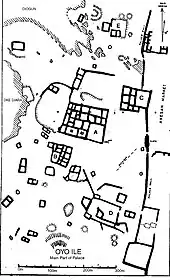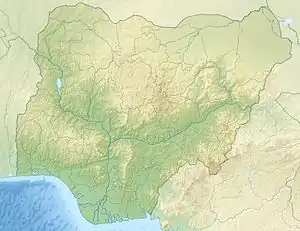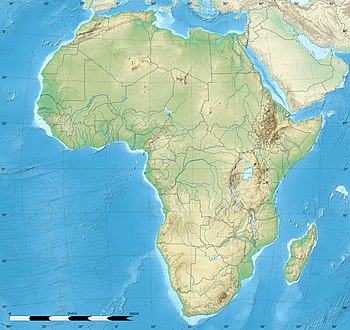 Survey by Brian Hallam | |
| Alternative name | Old Oyo, Oyo-Ile, Oyo Katunga (Hausa), Oyo-Oro, Eyo |
|---|---|
| Location | Old Oyo National Park, Oyo State, Nigeria |
| Coordinates | 8°58′29″N 4°18′27″E / 8.9746°N 4.3076°E |
| Type | Capital, City |
| History | |
| Founded | 1400s |
| Abandoned | 1835 |
| Site notes | |
| Public access | Old Oyo National Park |
Old Oyo (also known as Oyo-Ile, Oyo Katunga, Oyo-Oro, and Eyo) is the site of the capital city (1400-1835)[1] of the Oyo Empire (occasionally called the Old Oyo Empire) in what is now modern-day Nigeria. It was a major cultural and political center of West Africa during the empire's height.[2] Established by Yoruba groups migrating from the city of Ile-Ife, the city was the seat of authority for the Alaafin, or custodian/keeper of the palace which was called the Aafin. As capital of a major state during the 17th and 18th centuries, the city is also the site of large markets such as the Akesan market, which was recreated in the later city of New Oyo. Archaeology has been conducted at this site for over four decades.[3] The area designated as Old Oyo is nearly 3,000 hectares.[4] Sites related in cultural relation and importance to the Oyo Empire inclue Koso and Ipapo Ile, both cities in Nigeria.
Significance
The inspiration for the metropolitan, urban center that Old Oyo was comes from Yoruba history. The legend and history of Ile-Ife (Ile meaning home and Ife meaning expansion) originates in the original expansion of Yoruba peoples. Ile-Ife was settlement of the Yoruba travelers, absorbing those who were living in the area, and a place that became the Holy City of legend, the place of legendary creation and a center for their culture as they spread from this city to the surrounding lands.[5] In the cities that these Yoruba descendants established, the idea of a center such as Ile-Ife has been repeated. In this way, Old Oyo was a center for Yoruba culture, the destination of tributes, and the seat of ritual and political rule.[6] The empire at it's height had political power over other Yoruba kingdoms and the broader region of West Africa and the Bight of Benin, with a strong cavalry, trade system, and political organization.[7] The Alaafin who lived in the major palace complex within Old Oyo was both ruler and judge for their people.[8]

Geography

According to the National Commission for Museums and Monuments, Old Oyo historical site is located at the coordinates 8°56'-9° 03' North 4°20'- 4°26'East.
The site is situated South of River Niger, in a guinea savannah area. In the region of West Africa, Grassland Savanna and to a lesser extant Broadleaf Forests have been the dominant biome in the last 520 ka.[9]
The seasons of Nigeria alternate between rainy and dry, though, different from the North, the South has a longer rain, followed by shorter dry period, then followed by a short wet and long dry season.[10]
The land in Oyo state changes the further North one travels, transitioning from lowland into rocky terrain. The entire area has north-south flowing rivers and their tributaries. A study on groundwater potential in this region shows that within this state, there is a distribution of aquifers, though little groundwater potential.[11]
In the site of Old Oyo, there was a water reservoir located near the palace,[4] created as a water catchment area (15x100m[12]) from rainfall and wells, as the ground is rocky and difficult to dig. According to Johnson, the city of Oyo-Ile was separated into 11 sections, and, mirrored in the city of New Oyo, a minor district on the outskirts of the city was dedicated to Shango.[13]
Cultural history
This site has been lengthly occupied, and the effects of inhabitancy can be seen as changes to environment, horticulture, and visible human artifacts still present on the landscape. Of the archaeology, there are features; the remains of walls and
According to Frank Willett, the first Ife antiquity to be obtained by a European was sold at the Queen's market of Old Oyo.[14]
Located in what is now the Oyo state of Nigeria, the national park that preserves this area also extends into the Kwara state.
In the broader landscape of empires in this area, Oyo Empire at its height in 1780 was a larger than the surrounding coastal empires, and city of Old Oyo received tribute in the form of slaves, soldiers, taxes, etc. During this time, Agbaje-Williams estimates the population to be 60,000 to 140,000 people.[15] Phosphate surveys across the site reveal a spike in measurement near the area where the Akesan marketplace once lay. Anthropogenic changes to the natural environment in this site have resulted in baobab trees, useful shrubs, and thickets being more prevalent in areas of greater human occupation.[1]
The Oyo-Ile Kingdom during the crest of its power sponsored new kingdoms, located in Oyo, Egbado, Igbomina regions of Nigeria.[16]

Artifacts
Excavations have been carried out in 1981, 2002, 2004, 2006...
The Aafin area has visible remnants of walls and pottery, and excavations yield charcoal and potsherds to varying depths. Inside the Main Outer wall, mud walls (collapsed and seen as mounds) are again visible, with more intense occupation mounds. From this excavation, a ceramic plate was found that originates from a nearby material source. Eastern areas of these series of excavations show two occupation levels, whereas the test pit in the Western part in 2006 had one occupation. Pottery can visible partway buried in this area. In the area between the Outer wall and the Main Outer wall, material was not seen but excavations revealed pottery fragments.[1] Segi, dichroic beads, are found at Old Oyo similar to other sites in Yorubaland.[17]

Walls
The walls of the city had a wide circumference with ditches accompanying the walls, some of the ground dug building a second earthwork on the other side of the ditch. There are three divisions of wall that researchers have established in Old Oyo: those of the Outer, the Main Outer, and the Inner wall (Aafin).[1] 7.5 km encircling the Aafin,[4] 18 km of the Main Outer, and 28 km of the Outer.[4] The walls of Oyo-Ile have been mapped several times. In most areas they have collapsed or split, with the most enduring being those of the Inner circle, three inner and one outer of the walls surviving today (4.5x9m).[12]
Pottery
Pottery is found in abundance at this site.[18] Old Oyo pottery, as described by Dr. Ogiogwa, can include "characteristic burnishing, basting, brush marking, shell-edge, scallop impressions, dot punctuate, and incised geometric symbols consisting of cross, triangular, square, and perpendicular motifs.",[19] the Oyo ceramic complex. Restated in other papers, burnished-basted surfaces are signatures of Old Oyo ceramics.[2] These productions have been found in various sites within the empire as well as being found in Ijebu, potential putting Ijebu of a status with Ilesa in relation to the Oyo Empire, or simply having contact through trade, as both groups took advantage of their positions between sea and land. The two styles that archeologists have isolated at Old Oyo include Diogun and Mejiro. Typically, the pottery found in excavations within this site have local origins. Large pots had storage purposes, with those of medium sizes being used for cooking, and the smallest used as jars (grey/brown), bowls (typically dark grey/black),[2] lamps and plates.[1] In spite of the major changes in size and cultural reach, the changes in pottery style throughout the city's occupation are not extensive.[2] There is a lack of spores and pollen within the ceramics, which could be caused by a high firing temperature (more spores than pollen) or the origin of the clay had few plants.[19]
Diogun
A style of pottery found in layers before than the presence of walls. The dates for this occupation is (1100±110 AD), with further dating efforts adding dates as late as 765±90.[20] "These wares are characterized by sandy paste, fawn/ grey-brown colour, and complex fluted rims."[20]
Mejiro
The later style of pottery, labelled by Soper, was present at the nearby Mejiro cave. Characterized as grey/black wares,[20] the beginning date is 1300±80. In mid-later points of this stage, potters marks are distinguished which helps archeologists track the spread of the artisans and their products across the wide trade routes and the travels of the people of Old Oyo, as well as their dispersal after the city's collapse.
Ironworking
Large scale iron-working is known to be more prominent in the areas surrounding Old Oyo than in other regions of West Africa.[21] This is caused by rich deposits in the area, and greater iron-working enabled the military to be better-equipped, and the empire to expand further.[22]
Evidence of intense settlement
There are grinding hollows and grindstones found at this site.[4] Grinding hollows can be used for a variety of purposes, including food, pigment, ceramic, and metal production.[23]

Creation
According to The History of the Yorubas, the Oyo-Ile kingdom's founder was Oranmiyan.[24] Reasons for Yoruba migration from cities such as Ile-Ife have been attributed to long droughts or the unselected in a leadership dispute leaving with his adherents.[16] The Afin, the large palace complex, is a Yoruba tradition, while the sprawling market area signifies the role that mercantilism played in the maintenance and central focus of the Oyo empire. These are signatures of Yoruba cities, and the layout and features of Old Oyo were copied to New Oyo after the old city's abandonment.
Abandonment
This city was abandoned in 1835 after its destruction by Fulani attacks. This is what caused the shifting of the seat of power to New Oyo. The destruction of the city comes after a decline in trade and influence, the slave trade declined, the position that Oyo-Ile had in regards to this is what had enabled its prosperity while the surrounding kingdoms had less access, and the kingdoms surrounding Oyo-Ile had been gaining power.[25]
After it's abandonment in the late 1830s, it had not returned to city status until it was declared a game-reserve, later a national park.[26]
Position in the future
Areas of cultural history and heritage in Nigeria have been experiencing gradual decay and/or replacement in the recent past. Regeneration of these areas with urban communities can strengthen cultural identity and can help local and national communities access the tourism industry.
With studies on the proximal positions of Fez, Morocco and Kano, Old Oyo can feasibly be renewed.[27]
External links
References
- 1 2 3 4 5 Folorunso, C. A. (January 2006). "Revisiting old Oyo: Report on an interdisciplinary field study". University of Ibadan.
- 1 2 3 4 Ogundiran, Akinwumi O. (2001). "Ceramic Spheres and Regional Networks in the Yoruba-Edo Region, Nigeria, 13th-19th Centuries A.C." Journal of Field Archaeology. 28 (1/2): 27–43. doi:10.2307/3181458. ISSN 0093-4690.
- ↑ Agbaje-Williams, Babatunde (1990). "Field Report: Oyo Ruins of NW Yorubaland, Nigeria". Journal of Field Archaeology. 17 (3): 367–378. doi:10.1179/jfa.1990.17.3.367. ISSN 0093-4690.
- 1 2 3 4 5 Centre, UNESCO World Heritage. "Old Oyo". UNESCO World Heritage Centre. Retrieved 2023-11-28.
- ↑ Biobaku, Saburi (1958). "The pattern of Yoruba history" (PDF). African South. 2.
- ↑ Monroe, J. Cameron (2018-12-01). ""Elephants for Want of Towns": Archaeological Perspectives on West African Cities and Their Hinterlands". Journal of Archaeological Research. 26 (4): 387–446. doi:10.1007/s10814-017-9114-2. ISSN 1573-7756.
- ↑ Akintayo, Akinbowale M. "Conservation of Pottery Materials from the Old Oyo Empire". Cultural Heritage Conservation.
- ↑ Olukole, Titilayo O. "Cultural Heritage Resources of the New Oyo Empire, Southwestern Nigeria: Prospects for Sustainability". African Diaspora Archaeology Newsletter. 13 (4).
- ↑ Miller, Charlotte S.; Gosling, William D. (2014-01-15). "Quaternary forest associations in lowland tropical West Africa". Quaternary Science Reviews. 84: 7–25. doi:10.1016/j.quascirev.2013.10.027. ISSN 0277-3791.
- ↑ ASEGIEMHE, A. J. (June 2019). "Geography of Nigeria; A Practical Article on the Concise Location of Nigeria in Africa and Other of her Unique Features". Academia.edu.
- ↑ Agbede, Oluwole Akinyele; Aiyelokun; Oyelakin (July 2019). "Evaluation of Groundwater Potential through Aquifer Hydraulic Properties in Oyo State, Southwestern Basement Complex Nigeria". Department of Civil Engineering, University of Ibadan – via Researchgate.
- 1 2 "Old Oyo National Park". litcaf.com. 2021-03-18. Retrieved 2023-11-28.
- ↑ Goddard, Stephen (1971). "Ago That became Oyo: An Essay in Yoruba Historical Geography". The Geographical Journal. 137 (2): 207–211. doi:10.2307/1796741. ISSN 0016-7398.
- ↑ Willett, Frank (1960). "Ife and Its Archaeology". The Journal of African History. 1 (2): 231–248. ISSN 0021-8537.
- ↑ Agbaje-Williams, Babatunde (1983). A Contribution to the Archaeology of Old Oyo. University of Ibadan.
- 1 2 NOLTE, INSA (10 January 2012). "REEXAMINING THE YORUBA NATION - A History of the Yoruba People". The Journal of African History. 52 (3): 419–421. doi:10.1017/s0021853711000582. ISSN 0021-8537 – via Cambridge Core.
- ↑ Ogundiran, Akinwumi (2002). "Of Small Things Remembered: Beads, Cowries, and Cultural Translations of the Atlantic Experience in Yorubaland". The International Journal of African Historical Studies. 35 (2/3): 427. doi:10.2307/3097620. ISSN 0361-7882.
- ↑ Willett, Frank (December 1960). "INVESTIGATIONS AT OLD OYO, 1956—57: AN INTERIM REPORT". Journal of the Historical Society of Nigeria. 2 (1): 59 – via JSTOR.
- 1 2 Ogiogwa, Joan-Mary I. (October 2017). "Old Oyo or Ijebu-Oyo Pottery: The Vessels of Oke-Eri" (PDF). Africology: The Journal of Pan African Studies. 10 (9).
- 1 2 3 Allsworth-Jones, P. (1996). "Continuity and Change in Yoruba Pottery". Bulletin of the School of Oriental and African Studies. 59 (2): 312–322. doi:10.1017/s0041977x00031591. ISSN 0041-977X.
- ↑ "Expedition Magazine | Benin, Oyo, and Dahomey". Expedition Magazine. Retrieved 2023-11-08.
- ↑ Ross, Authors: Emma George. "The Age of Iron in West Africa | Essay | The Metropolitan Museum of Art | Heilbrunn Timeline of Art History". The Met’s Heilbrunn Timeline of Art History. Retrieved 2023-11-08.
- ↑ Shoemaker, Anna C.; Davies, Matthew I.J.; Moore, Henrietta L. (2017-09-01). "Back to the Grindstone? The Archaeological Potential of Grinding-Stone Studies in Africa with Reference to Contemporary Grinding Practices in Marakwet, Northwest Kenya". African Archaeological Review. 34 (3): 415–435. doi:10.1007/s10437-017-9264-0. ISSN 1572-9842.
- ↑ "ORIGIN AND EARLY HISTORY", The History of the Yorubas, Cambridge University Press, pp. 3–14, 2010-09-30, retrieved 2023-10-30
- ↑ "Yoruba empire of Oyo". Oxford Reference. Retrieved 2023-10-30.
- ↑ Okpoko, A. Ikechukwu (May 1998). "ARCHAEOLOGY AND THE STUDY OF EARLY URBAN CENTRES IN NIGERIA" (PDF). African Study Monographs. 19 (1).
- ↑ Madandola, Muhammed; Boussaa, Djamel (2023-01-19). "Cultural heritage tourism as a catalyst for sustainable development; the case of old Oyo town in Nigeria". International Journal of Heritage Studies. 29 (1–2): 21–38. doi:10.1080/13527258.2023.2169332. ISSN 1352-7258.